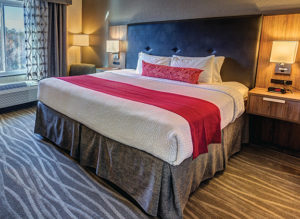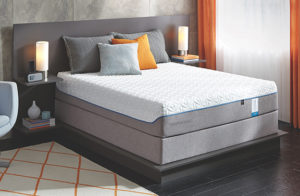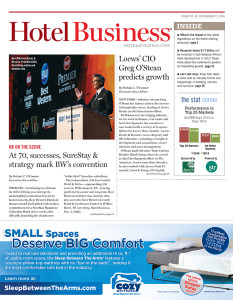You can’t have a hotel without furniture. Or, certainly, a guestroom without bedding & linens. Then, there’s the on-premises laundry equipment to wash and dry the latter, keeping the sheets and towels crisp and clean for the guests—a huge must when it comes to customer satisfaction.
As guests demand—and, now, have come to expect—their hotel experiences to be not only clean and comfortable but also unique, industry manufacturers have come a long way to deliver the goods. Not just in the aforementioned categories, which we examine on the next few pages, but in all product types from flooring to lighting to wallcoverings. Whether it’s the location that makes the experience, or the stay, the hotel and all it has to offer in terms of products and services is the common denominator.
Hotel Business talked shop with industry partners from the manufacturing side to get a take on what’s trending in bedding & linens, laundry and furniture, what’s coming down the line, and what owners want when purchasing these products for their hotels.
—Christina Trauthwein
Industry strives to keep things clean, cool and comfortable for guests
While much of the hotel experience today is focused on public areas—as guests leave the guestrooms for more social experiences—the bed is still a critical component of a guest’s stay. After all, much like the princess who slept on a pea, guests aren’t going to enjoy their travels if they can’t get a restful night’s sleep. And, nothing can make a room look more dated than outmoded bedding & linens.
Comfort, of course, is key. According to Greg Cremeans, VP national accounts-hospitality, Tempur Sealy, “We’re seeing a rise in guest expectations regarding hotel bedding. That’s because guests expect their hotel mattresses to be at least as comfortable as what they have at home—and the mattresses they have at home are increasing in quality as well as diversity.” More people are buying foam and hybrid mattresses for their homes at every price point, according to Furniture Today’s “2015 Bedding Buying Trends” survey—and foam and hybrids comprise 58% of mattress purchases ranging from $1,000–$1,999, said Cremeans. “It’s only logical that the people who prefer these beds at home also prefer them at hotels. To meet these guest expectations, Tempur Sealy recommends that luxury hotels upgrade a select block of rooms with either foam or hybrid mattresses,” said Cremeans.
Temperature is an important feature of the mattress. Rick Sequeira, VP, Simmons Hospitality Bedding, said, “The latest innovation in mattress technology is all about temperature-management design—from the inside out. Sleep disturbance due to temperature is a common consumer and guest complaint. Keeping the room cool is one option, but getting out of bed in a cold room is not a great way to start the day. What if you could manage temperature a different way? What if a cool, more comfortable night’s sleep started with the bed itself?” he asked, noting that Simmons Beautyrest line features an exclusive temperature-management design with foams that allow for the circulation of air, mitigating heat from accumulating in the mattress.
And, it’s not just the mattress manufacturers looking to solve temperature management. “We’re seeing innovations in sleep technology designed to offer guests a better night’s sleep,” said Sandra DiVito, VP of hospitality and healthcare at Protect-A-Bed. “For example, a significant percentage of guests sleep ‘hot,’ which means they are exceptionally warm in their beds and wake up hot and uncomfortable. Guests are actively seeking ways to cool their body temperature as they sleep, and thereby wake up refreshed and revitalized. As a result, new fabrics with thermal-regulating properties are being introduced to hotels.”
She noted that the company is introducing a line of mattress and pillow protectors with a Nordic Chill fiber, which transfers heat away from a guest’s skin to provide an instant cooling sensation. “Nordic Chill feels cooler because of thermal conductivity, the ability to transfer heat away from a guest’s skin to provide an instant cooling sensation. This feature helps hot sleepers reduce their surface temperature, allowing them to sleep more comfortably,” she said. The product is also a cloth, waterproof mattress/pillow protector that protects against allergens and moisture contamination.
From a practical standpoint, Sequeira said he’s seeing increased interest in two-sided mattresses. “Property owners like the ability to turn and flip a mattress in order to provide longer-lasting guest comfort while extending this critical guestroom investment,” he said. “The design also provides benefits for housekeeping, because the natural crown it creates allows sheets to be secured without having to lift the corners of the mattress.”
Looking to the retail market, he said that adjustable beds remain a growing segment. “If costs come down and the durability concerns get addressed, you could see some high-end suites begin to use these type of mattresses,” Sequeira said. And, of course, sustainability is also top-of-mind. “From product development and manufacturing to logistics, property owners are looking to work with companies that adhere to the principles of sustainability in virtually all aspects of their operations,” he said.

Star Textile’s Tanya Hendershot noted that white beds with pops of color are still popular with hotel owners and guests.
Tanya Hendershot, director of hospitality sales, Star Textile Inc., noted that along with comfort, cleanliness has become increasingly important. “I believe that the cleanliness of all of the bedding items, from sheeting and duvet inserts right down to decorative accent pillows, has become a top priority, more so in recent years,” she said.
DiVito agreed about the importance of cleanliness. “Hotel owners have realized that using a thin, felt-layer product or quilted mattress pad doesn’t secure mattress hygiene. Instead, hotel owners prefer multiple-solution products,” she said, noting that encasements help prevent liquid damage as well as allergens like dust, dust mites, dead skin and mold.
Hendershot said that when it comes to the look of the bed, white still reigns supreme. “We are still seeing trending towards the white bedding with attractive bed scarfs added as a decorative feature in custom patterns and or textures,” she said. “Adding pops of color on the accent pillows is also still very trendy; recently, I have seen requests for monogrammed or logo-style accent pillows as well, especially in boutique-style properties.”
Kerry Galloway, SVP of contract sales, The Robert Allen Group, agreed. “White top-of-bed options continue to be very popular and have been introduced to some degree in almost every hotel segment,” he said. “White textural third sheets are a major trend… There seems to be a trend toward modern, sleek, contemporary looks—clean lines with subtle texture.”
According to Laura Arendt, senior product development manager, hospitality, 1888 Mills LLC, gray is also gaining traction in hospitality. “Right now, in both home textiles and hospitality, gray as the new neutral continues to grow. Properties, both new and renovations, are adding gray touches to all aspects of the room, including bedding,” she said. “We have extended our Beyond Textures top-of-bed collection to include a solid gray top sheet this year, and have had a great response… I think this year, you will see more color and unique printed elements added to top-of-bed that will be very interesting.”
Added Galloway, “We’ve recently launched a reversible matelassé coverlet that gives the property an all-white solution on one side, and a neutral color top-of-bed with a turnover of white on the reverse side. These products were designed for hoteliers who still want a pop of color on top-of-bed. Additionally, to complement the ever-present all-white solution, we are expanding our bedding accent pieces with more texture and colors to add additional sophistication and energy to the guestroom.”
Hendershot pointed to the difference between larger brands, which have exclusive bedding schemes implemented, and those that don’t: “As a manufacturer of bedding, working with clients who have the luxury of selecting the top-of-bed for the property is a nice feature,” she said. “This allows the design and/or decor of the location to also be an element of inspiration for the colors or themes used for the bedding.”
Arendt said she’s been seeing continued growth, particularly in the luxury segment. “This year, we introduced our Elite Since 1888 luxury linen and bath collections, and we have had a great response. It allows us to showcase different fibers and styles for all the different types of luxury properties,” she said.
In addition to color schemes, Arendt said the beds have gotten an update. “Definitely, the trend has been growing to update the look of the bed from a traditional to a more modern feel with the platform bed. This has given us the opportunity to rethink how beds are put together,” she said. “This year, 1888 launched an extension to our classic decorative top-of-bed line, Adorn, and added bed wraps. This new item has helped properties upgrade from bed skirts to bed wraps more easily.”
Galloway added there is “an increasing demand for box-spring covers and less of an emphasis on bed skirts.”
Tempur Sealy’s Cremeans noted how important it is for hoteliers to focus on bedding. “These days, hotel owners expect their guests to check online reviews when considering hotels. Owners know that what their guests write about their stay has a big impact on future occupancy rates. In fact, travelers are 3.9 times more likely to book the hotel with higher reviews when prices are equal, according to a recent TrustYou study,” Cremeans said. “And, as the centerpiece of any hotel room, the bed has a big impact on guest reviews.”
Sequeira added, “Hotels everywhere continue to make the guest sleep experience a priority, which makes sense when you really think about it. What you expect when you stay at a hotel is the promise of a good night’s sleep. Key hotel brands have invested significantly toward this goal, understanding the power of this key differentiator and its impact on guest satisfaction and loyalty.”


